Medion MAM 2070 user Manual

NOTES ON THIS MANUAL
Keep these instructions with your computer at all times. The proper set up, use and care can help extend the life of your computer. In the event that you transfer ownership of this computer, please provide these instructions to the new owner.
This manual is divided into sections to help you find the information you require. Along with the Table of Contents, an Index has been provided to help you locate information.
In addition, many application programs include extensive help functions. As a general rule, you can access help functions by pressing F1 on the keyboard. These help functions are available to you when you use the Microsoft Windows® operating system or the various application programs.
We strongly recommend that you read the Online Manual for your Notebook, which can be found in the Start Menu.
ÂImportant: Additional information about your notebook can be found in the online help in the Start Menu of your notebook. Click on:
 Information about your notebook
Information about your notebook
This interactive manual is designed to provide additional information about your Notebook as well as useful links accessible via the World Wide Web.
Windowsxp invites you to a tour (notes on the task bar) to familiarize yourself with the operating system. We listed further useful sources of information starting on page 66.

AUDIENCE
These instructions are intended for both the novice and advanced user. Regardless of the possible professional utilization, this Notebook is designed for day-to-day household use. The functions and applications for use with this Notebook have been designed with the entire family in mind.
DOCUMENT YOUR NOTEBOOK
It is important to document the details of your Notebook purchase in the event you need warranty service. The serial number can be found on the back of the Notebook:
Serial Number ......................................
Date of Purchase ......................................
Place of Purchase ......................................
QUALITY
We have selected the components in this computer for their high level of functionality, ease of use, safety and reliability.
Through balanced hardware and software design we are able to provide you with an innovative personal computer useful for applications relating to both work and leisure.
We are pleased to welcome you as our newest customer.
Copyright© 2005. All rights reserved.
The appliance is supposed to be used in Great Britain.
Microsoft®, MS-DOS®, and Windows are registered trademarks of Microsoft Corporation in the U.S. and other countries. Pentium® is a registered trademark of Intel Corporation. The names of actual companies and products mentioned herein may be the trademarks of their respective owners.
This product incorporates copyright protection technology that is protected by method claims of certain U.S. patents and other intellectual property rights owned by Macrovision Corporation and other rights owners. Use of this copyright protection technology must be authorised by Macrovision Corporation, and is intended for home and other limited viewing uses only unless otherwise authorized by Macrovision Corporation. Reverse engineering or disassembly is prohibited.
Information in this document is subject to change without notice.
ii

Table of Contents: |
|
SAFETY AND MAINTENANCE........................................................ |
1 |
Safety Instructions................................................................... |
3 |
Data Security ....................................................................... |
4 |
Set-Up Location.................................................................... |
5 |
Ambient Temperature............................................................ |
5 |
Power Adapter...................................................................... |
6 |
Power supply ................................................................... |
6 |
Cabling ........................................................................... |
6 |
Modem................................................................................ |
7 |
Information about the regualtory compliance of wireless Lan....... |
7 |
Touch Pad............................................................................ |
7 |
Battery Operation ................................................................. |
8 |
VIEWS & HANDLING.................................................................... |
9 |
Views ................................................................................... |
11 |
Included with Your Notebook ................................................ |
11 |
Open Notebook .................................................................. |
12 |
Front View ......................................................................... |
13 |
Left Side............................................................................ |
14 |
Right Side.......................................................................... |
14 |
Rear Side .......................................................................... |
14 |
Indicators .......................................................................... |
15 |
Getting Started...................................................................... |
17 |
Short description of the Windows® Desktop ............................ |
20 |
Working in Comfort ............................................................. |
22 |
MAIN COMPONENTS .................................................................. |
23 |
Power Supply ........................................................................ |
25 |
On/Off Button .................................................................... |
25 |
Power Adapter.................................................................... |
26 |
Battery Operation ............................................................... |
27 |
Inserting the Battery....................................................... |
27 |
Removing the battery...................................................... |
28 |
Charging the Battery....................................................... |
29 |
Discharging the battery ................................................... |
29 |
Battery Power ................................................................ |
30 |
Power Management............................................................. |
31 |
Standby Mode................................................................ |
31 |
Suspend (hibernate) Mode ............................................... |
31 |
Display................................................................................. |
32 |
Opening and Closing the Display ........................................... |
32 |
Screen Resolution ............................................................... |
33 |
Connecting an External Monitor ............................................ |
34 |
Connecting a TV ................................................................. |
36 |
iii

Data Entry ............................................................................ |
37 |
The Keyboard..................................................................... |
37 |
Notebook-Specific Key Combinations ................................. |
37 |
Touch Pad.......................................................................... |
38 |
The Hard drive ...................................................................... |
39 |
Important Directories .......................................................... |
40 |
The Optical Drive ................................................................... |
41 |
Loading a Disc.................................................................... |
42 |
Emergency Ejection of a Blocked Disc................................ |
43 |
Playing Back and Retrieving Data from Discs ...................... |
44 |
Quick Player .................................................................. |
44 |
DVD Technology ................................................................. |
45 |
Various DVD Formats .......................................................... |
45 |
DVD-Video......................................................................... |
46 |
Regional Playback Information for DVD.............................. |
47 |
Subjects Concerning the CD/DVD-Rewriter ............................. |
48 |
Recordable/Rewriteable Discs........................................... |
48 |
The Sound Card..................................................................... |
49 |
External Audio Ports............................................................ |
49 |
Modem ................................................................................. |
52 |
What is a Modem? .............................................................. |
52 |
Modem Port ....................................................................... |
53 |
The Network ......................................................................... |
54 |
What is a network? ............................................................. |
54 |
Fast Ethernet-Network .................................................... |
54 |
Troubleshooting within the Network....................................... |
57 |
Wireless LAN.................................................................. |
58 |
Multimedia Card Reader .......................................................... |
59 |
Inserting Memory Cards....................................................... |
59 |
Removing Memory Cards ..................................................... |
59 |
The PC Card Slot.................................................................... |
60 |
32-bit CardBus Port............................................................. |
60 |
Use of PC Cards.................................................................. |
60 |
Installing a PC Card ........................................................ |
61 |
Removing a PC Card ....................................................... |
61 |
Universal Serial Bus (USB) Port................................................ |
62 |
IEEE 1394 (FireWire®) ............................................................ |
63 |
Application Options for IEEE1394 .......................................... |
63 |
Technical Specifications ....................................................... |
63 |
Bluetooth (optional feature)..................................................... |
64 |
Activate Bluetooth .............................................................. |
65 |
Inactivate Bluetooth............................................................ |
65 |
Infrared Interface .................................................................. |
66 |
Instructions for Using the IR port .......................................... |
66 |
iv

Software............................................................................... |
67 |
Getting to Know Windows XP................................................ |
67 |
Windows® XP Manual ...................................................... |
67 |
Windows® XP Help and Support ........................................ |
67 |
Microsoft® Interactive Training ......................................... |
68 |
Installation of Software........................................................ |
69 |
Software Deinstallation.................................................... |
71 |
Windows Activation......................................................... |
71 |
The BIOS Set-up-Program.................................................... |
72 |
Running the BIOS Set-up................................................. |
72 |
Navigating the BIOS Utility .............................................. |
72 |
FIRST AID ................................................................................. |
73 |
FAQ – Frequently Asked Questions ........................................... |
75 |
Data and System Security ....................................................... |
77 |
Data Security ..................................................................... |
77 |
Maintenance Programs ........................................................ |
77 |
Password Reset Disk ....................................................... |
77 |
Windows® Update ............................................................... |
78 |
Windows Update Information for Data Security ................... |
79 |
System Recovery ................................................................... |
80 |
Correction.......................................................................... |
80 |
System Restore powered by Symantec .................................. |
81 |
Limits of the Recovery..................................................... |
82 |
Performing the Restore.................................................... |
82 |
Troubleshooting..................................................................... |
83 |
Localize the Cause .............................................................. |
83 |
Check Cables and Connections ......................................... |
83 |
The Power On Self Test (POST)......................................... |
83 |
Errors And Possible Causes .............................................. |
84 |
Additional Support .............................................................. |
85 |
Driver Support ................................................................... |
85 |
Maintenance.......................................................................... |
86 |
Care of the TFT Display........................................................ |
86 |
Transporting the Notebook ................................................... |
87 |
Recycling and Disposal ........................................................ |
88 |
Batteries and Proper Treatment ............................................ |
89 |
Securing your Notebook....................................................... |
90 |
Setting a User Password .................................................. |
90 |
Using a safety lock ......................................................... |
90 |
Upgrades and Repairs.......................................................... |
90 |
Notes for Service Engineers ............................................. |
91 |
v

APPENDIX ................................................................................. |
93 |
Standards ............................................................................. |
95 |
Electromagnetic Compatibility............................................... |
95 |
ISO 13406-2 Class II........................................................... |
95 |
FCC Compliance Statement .................................................. |
97 |
Warranty .............................................................................. |
98 |
Liability limitations .............................................................. |
99 |
Copying this manual............................................................ |
99 |
Index .................................................................................. |
100 |
Device 
At the end of its life, the appliance must not be disposed of in household rubbish. Enquire about the options for environmentallyfriendly disposal
Batteries 
Do not dispose of used batteries in the household rubbish! They must be deposited at a collection point for used batteries.
vi

 Chapter 1
Chapter 1
Safety and Maintenance
Subject |
Page |
Data Security.................................................... |
4 |
Set-up Location................................................. |
5 |
Ambient Temperature ...................................... |
5 |
Power Adapter .................................................. |
6 |
Modem ............................................................ |
7 |
Wireless Lan ..................................................... |
7 |
Touch Pad ........................................................ |
7 |
Battery Operation.............................................. |
8 |
Safety
Usage
Components
Help
Appendix

2 |
|
SAFETY AND MAINTENANCE |

SAFETY INSTRUCTIONS
Please follow the instructions in this section for the safe operation of your notebook:
*Do not allow small children to play unattended with electrical equipment. Children are incapable of judging potential risks properly.
*Do not open the case of the notebook, the battery or the power adaptor. When the case is open there is a danger of severe electric shock.
*CD-ROM-/CDRW-/DVD-drives are Laser Class 1 devices. These lasers must remain in their sealed casing. DO NOT remove the drive covers, as exposure to the lasers may be harmful.
*Do not insert objects through the slots and openings of the notebook. This may lead to electric shock, electrical shortcircuit or fire that will damage your notebook.
*Slots and openings in the notebook serve to ventilate it. Do not cover up these openings, because the notebook could overheat otherwise.
*The notebook is not intended to be operated in a heavy industry company. Operation under extreme environmental conditions can result in damage to your notebook.
*Do not operate the notebook during a thunderstorm, in order to avoid damage through lightning strike.
*Do not cover the slots and openings of the notebook. Never place objects on top of the notebook that would exert any pressure on the display. There is a danger that even slight pressure may break the TFT display.
SAFETY INSTRUCTIONS |
|
3 |
Safety
Handling
Components
Help
Appendix
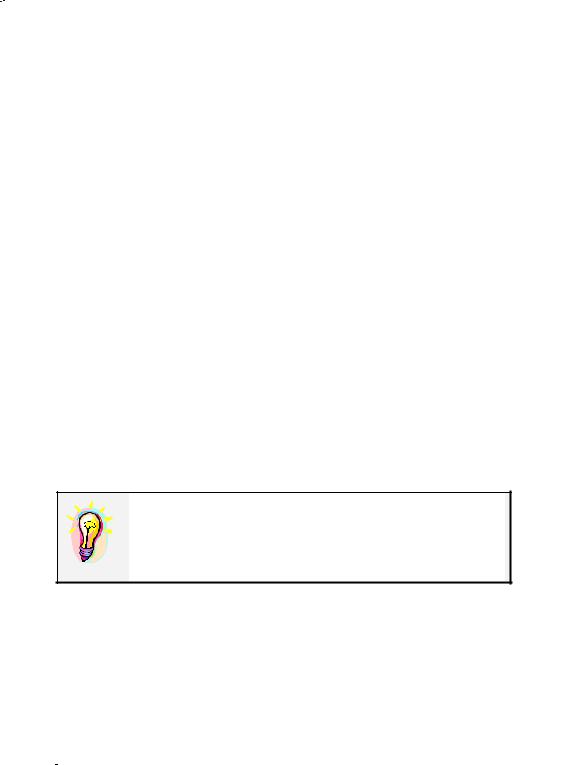
*There is a risk of injury if the TFT display breaks. Use protective gloves to pack up the broken pieces and contact customer service to arrange for proper disposal. It is important to thoroughly wash your hands after handling a broken TFT display. There is a chance that chemicals may have been released.
*To avoid damage to the TFT Display, never open it a full 120º. Do not forcibly open it.
*In order to avoid damage to the display, do not touch it with your fingers or sharp objects.
*Never lift the notebook by the TFT Display; doing so could break the hinges.
Switch off your PC immediately or do not switch it on at all and contact customer service …
♦… if the power cord or the connectors attached to it are burnt or damaged. Replace the defective power cord with an original power cord. Under no circumstances may a defective power cord be repaired.
♦... if the housing of the PC is damaged or fluids have leaked into it.
Have the PC checked by customer service first, because the PC may not be safely operated otherwise and there may be a life-threatening risk of electrocution!
DATA SECURITY
Every time you update your data make back-up copies on an external storage medium. The supplier does not assume liability for data loss or damage to data storage units, and no claims can be accepted for damages resulting from the loss of data or consequential losses.
4 |
|
SAFETY AND MAINTENANCE |

SET-UP LOCATION
•Keep your notebook and all connected peripherals away from moisture, dust, heat and direct sunlight. Failure to do so can lead to Notebook malfunction or damage.
•It is highly recommended you do not use the notebook outdoors.
•Operate the notebook and all peripherals on a stable, balanced and vibration-free surface.
•Do not leave the base of your notebook on your lap or any part of your body for a long period of time. The notebook can become very warm while it is turned on or charging and can cause discomfort or injury from heat exposure.
AMBIENT TEMPERATURE
•The notebook is most reliably operated at an ambient temperature between +41° and +104° F and at a relative humidity between 20% and 80% (without condensation).
•When powered off, the notebook can be stored at temperatures between 32° and 140° F.
SAFETY INSTRUCTIONS |
|
5 |
Safety
Handling
Components
Help
Appendix

POWER ADAPTER
Pay attention to the following information, in order to connect your notebook correctly:
POWER SUPPLY
*Do not open the power adapter housing. When the housing is open there is a danger of severe electric shock. It contains no user-serviceable parts.
*The electric outlet must be in the vicinity of the notebook and within reach of the power adapter cables.
*To disconnect your notebook from the power source, or set the notebook to battery operation, remove the power cord from the notebook’s power socket.
*Only use the notebook with a power adaptor operating at AC 115V~/60 Hz. In European countries use the notebook at AC 220-240V~/50 Hz.
For details on power consumption, please refer to the rating plate on the rear of your notebook. If you are unsure of the type of power supply available at the point of use, ask your local power company.
*Use only the supplied power cord and power adapter.
*If using an extension cord, make certain that it meets your local safety requirements. If in doubt, consult an electrician.
*To provide additional protection against electric shock, power surges, lightning strikes, or other electrical damage to your notebook, we recommend the use of a surge protector.
*Firstly remove the plug, and then the connector of the notebook, from the power source, if you want to detach the network adapter from the mains power supply. A reverse sequence could damage the network adapter or the notebook. Always hold the connector firmly when removing it. Never pull on the power cord.
CABLING
*Arrange cables so no one can walk on or trip over them.
*Do not place objects on any of the cables.
6 |
|
SAFETY AND MAINTENANCE |

MODEM
*If your system has a modem, please make sure you connect it to an analogue telephone line only. Connecting to a digital PBX, a digital line designed for broadband services or ISDN, a shared service line or a payphone will damage the modem or the devices to which it is connected.
This notebook, if equipped with a modem, has been tested according and complies with the European regulatory guidelines for radio equipment and telecommunication installations (R&TTE 1999/5/EG).
The modem meets the requirements of TBR21 (01/1998) and EG201120/V1.1.1/01/98 regarding connection with an analog telephone network.
INFORMATION ABOUT THE REGUALTORY COMPLIANCE OF WIRELESS LAN
The following low power radio equipment, which has separately been tested and approved according R&TTE guideline (1999/5/EC), is bundled with this PC:
-Wireless Lan
These radio devices are marked individually with the CE mark.
TOUCH PAD
Light pressure with the tip of your finger is all that is required to operate the touch pad. Because the touch pad is electrostatic sensitive, objects cannot be used in place of your fingers. Using a pen or other object can damage the touch pad or cause the notebook to malfunction.
SAFETY INSTRUCTIONS |
|
7 |
Safety
Handling
Components
Help
Appendix

BATTERY OPERATION
To extend the life and power of your battery and guarantee secure operation, the instructions below should be followed:
*Never expose the battery to direct sunlight or heat for long periods.
*Do not dispose of the battery by fire.
*Disregarding these instructions will lead to damage and under some circumstances may even cause the battery to explode.
*Do not open the battery housing; it contains no userserviceable parts.
*Keep the battery away from electrically conductive materials, chemical substances and cleaning agents.
*Only use the originally supplied power adapter to charge the battery.
*Ensure (through the display or the signalling sound of the notebook) that the battery is completely discharged before recharging it.
*Replace the battery only with the same type or an equivalent type recommended by the manufacturer.
*Charge the battery only until the battery charging light goes out. Also, refer to the instructions under “Charging the Battery” on page 29 for instructions on checking the battery level.
*Only change the battery when the unit is switched off.
*Batteries are classified as special waste and should always be disposed of properly. Contact Customer Service for more details.
8 |
|
SAFETY AND MAINTENANCE |

 Chapter 2
Chapter 2
Views & Handling
Subject |
Page |
Included with your notebook |
........................... 11 |
Open notebook ............................................... |
12 |
Front view ...................................................... |
13 |
Left Side ........................................................ |
14 |
Right Side ...................................................... |
14 |
Rear Side ...................................................... |
14 |
Power and Status Indicators ............................. |
15 |
Getting started................................................ |
17 |
Working in comfort .......................................... |
22 |
Safety
Handling
Components
Help
Appendix

10 |
|
VIEWS & HANDLING |

VIEWS
INCLUDED WITH YOUR NOTEBOOK
Please check that the contents are complete and notify us within 14 days of purchase if any of the following components are missing:
Notebook
Battery
Power adapter with connection cable
(Model: FSP090-1ADC21)
Modem cable
Application-/Support-Disc
Microsoft Windows® XP Recovery Disc + manual
User manual
Warranty card
VIEWS
Safety
Handling
Components
Help
Appendix
11

OPEN NOTEBOOK
1
2
3
4
5 |
|
5 |
|
|
|
6 |
|
|
7
8
9
5 |
|
10 |
|
5 |
1- TFT display (Ö p. 32)
2- AC power indicator  (Ö p. 15)
(Ö p. 15)
3- Battery charge indicator  (Ö p. 15)
(Ö p. 15)
4- Battery power indicator  (Ö p. 15)
(Ö p. 15)
5- Stereo speaker set
6- Power ON/OFF (Ö p. 25)
7- Keyboard (Ö p. 37)
8- Touch pad (Ö p. 38)
9- Microphone 
10- Device indicators (Ö p. 15)
12 |
|
VIEWS & HANDLING |
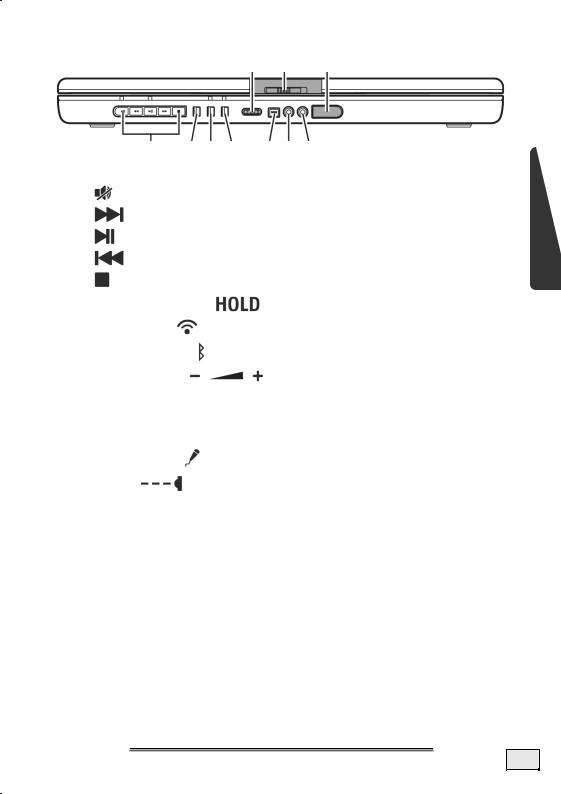
FRONT VIEW
15 17 20
|
|
11 |
|
12 |
|
13 |
|
14 |
|
16 |
|
18 |
|
19 |
|
11 |
- Quick player buttons (Ö p. 44) |
|
|
|
|
||||||||||
|
Mute |
|
|
|
|
|
|
|
|
|
|
|
|
||
|
Next track |
|
|
|
|
|
|
|
|
|
|||||
|
Play / pause |
|
|
|
|
|
|
|
|
|
|||||
|
Previous track |
|
|
|
|
|
|
||||||||
|
Stop |
|
|
|
|
|
|
|
|
|
|
|
|
||
12 |
- Quick player switch |
|
|
|
(Ö p. 44) |
||||||||||
13 |
- WLAN switch |
|
(Ö p. 58) |
|
|
|
|
|
|
||||||
14 |
- Bluetooth switch |
|
[optional] (Ö p. 64) |
||||||||||||
15 |
- Volume control |
|
|
|
|
|
|
|
|
|
|
|
|||
16 |
- IEEE 1394 (FireWire®) (Ö p. 63) |
|
|
|
|||||||||||
17 |
- Display catch (Ö p. 32) |
|
|
|
|
|
|
||||||||
18 |
- Audio Out (Ö p. 49) |
|
|
|
|
|
|
|
|
|
|||||
19 |
- Microphone In |
|
|
(Ö p. 49) |
|
|
|
|
|||||||
20 |
- IR port |
(Ö p. 66) |
|
|
|
|
|
|
|||||||
VIEWS
Safety
Handling
Components
Help
Appendix
13
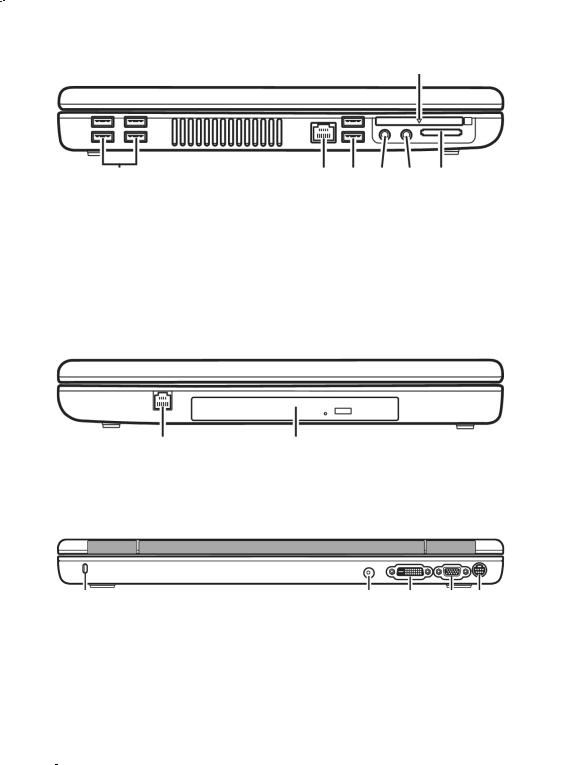
LEFT SIDE
26
21 |
|
22 |
|
21 |
|
23 |
|
24 |
|
25 |
|
|
|
|
|
|
|
|
|
|
|
21 - USB 2.0 port  (Ö p. 62) 22 - LAN port (RJ-45)
(Ö p. 62) 22 - LAN port (RJ-45)  (Ö p. 54)
(Ö p. 54)
23 - Digital audio out (SPDIF) (Ö p. 49) 24 - Line in  (Ö p. 49)
(Ö p. 49)
25 - Multimedia card reader  (Ö p. 59) 26 - PC card slot PCMCIA, type II (Ö p. 60)
(Ö p. 59) 26 - PC card slot PCMCIA, type II (Ö p. 60)
RIGHT SIDE
27 |
|
28 |
27 - Modem port (RJ-11)  (Ö p. 53) 28 - Optical Drive (Ö p. 41)
(Ö p. 53) 28 - Optical Drive (Ö p. 41)
REAR SIDE
29 |
30 |
31 |
32 |
33 |
29 - Kensington lock  (Ö p. 90)
(Ö p. 90)
30 - Power socket  (Ö p. 25)
(Ö p. 25)
31 - External monitor (DVI)  (Ö p. 34) 32 - External monitor (VGA)
(Ö p. 34) 32 - External monitor (VGA)  (Ö p. 34) 33 - Video out s-video (Ö p. 36)
(Ö p. 34) 33 - Video out s-video (Ö p. 36)
14 |
|
VIEWS & HANDLING |
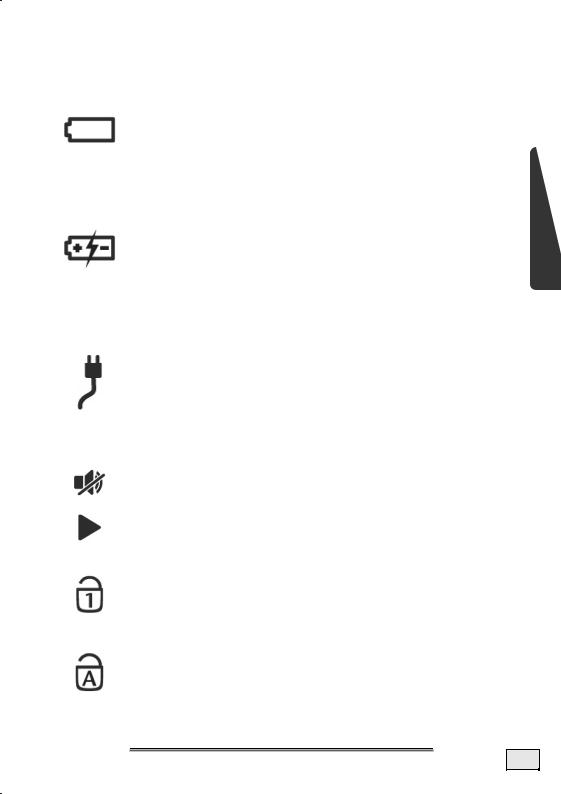
INDICATORS
LED's indicate the power and operating system states of the notebook. The meaning of each LED is:
BATTERY POWER INDICATOR
Below you will see the different meanings of the LED in various situation:
On |
The notebook is in full operation. |
|
|
Blinking |
The notebook is in stand-by mode. |
|
|
BATTERY CHARGE INDICATOR
Below you will see the different meanings of the LED in various situation:
Yellow |
The battery is being charged. |
|
|
Blue |
The battery is fully charged and connected |
|
to AC power. |
|
|
AC POWER INDICATOR
Below you will see the different meanings of the LED in various situation:
On |
The notebook is turned on. |
|
|
Blinking |
The notebook is in stand-by mode. |
|
|
MUTE INDICATOR
This LED light when the mute switch is turn on.
QUICK PLAYER INDICATOR
This LED light when the quick player is turned on during system off state.
NUM LOCK
This LED lights when NUM-Lock has been activated. It sets the keyboard so that numbers are assigned to certain characters, simplifying numerical data input.
CAPITAL LOCK
This LED lights when CAPS-Lock has been activated. This sets the keyboard to capital letters.
VIEWS
Safety
Handling
Components
Help
Appendix
15
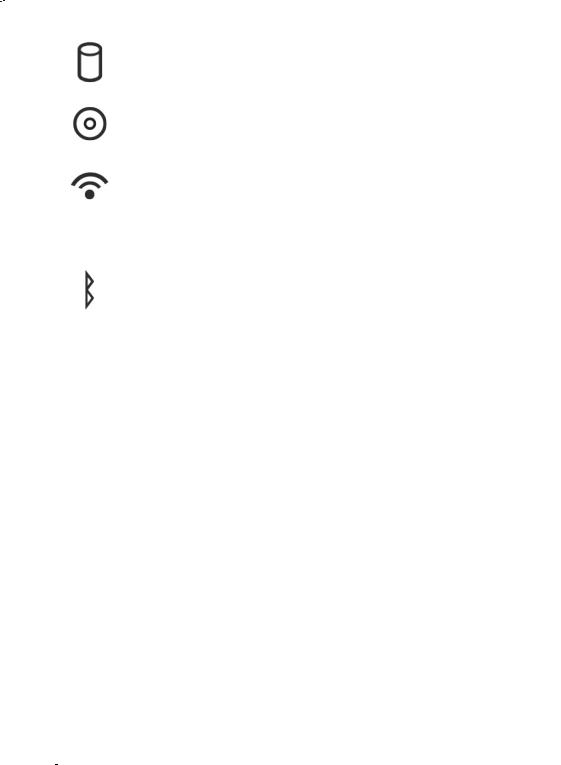
ACCESS LED
This LED lights when the notebook is accessing the hard disk.
ACCESS LED OPTICAL DRIVE
This LED lights or is blinking when the notebook is accessing the optical drive.
WIRELESS LAN
Display for wireless data exchange. If the display lights
steadily the wireless LAN function is enabled (optional feature).
BLUETOOTH
Display for wireless data exchange. If the display lights
steadily the Bluetooth function is enabled (optional feature).
16 |
|
VIEWS & HANDLING |
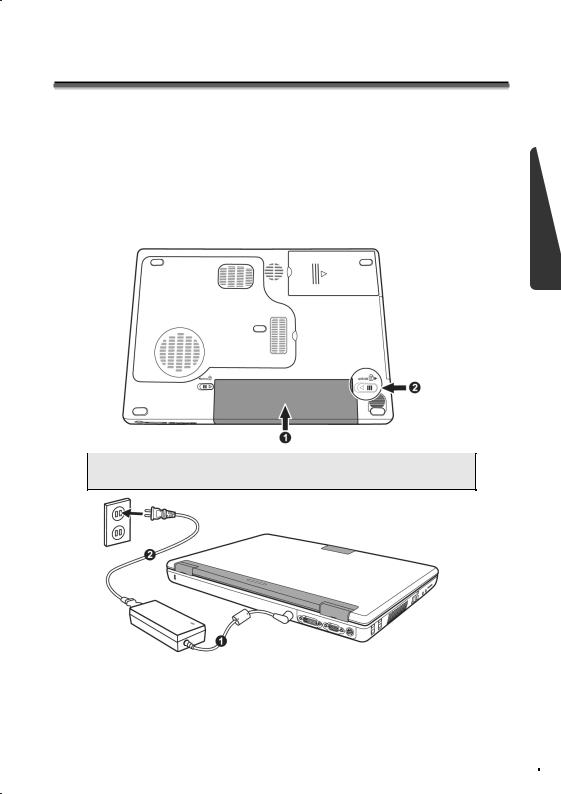
GETTING STARTED
Before you get started using your notebook, first take a few moments to read the important section on Safety.
This notebook comes with software fully pre-installed. You do not have to install any of the CDs supplied.
Step 1
•Insert the battery before bringing the notebook into operation by sliding the battery pack into the compartment.
Safety
Handling
Components
ÂIf the battery level is insufficient, connect the power adapter.
Help
Appendix
GETTING STARTED |
|
17 |
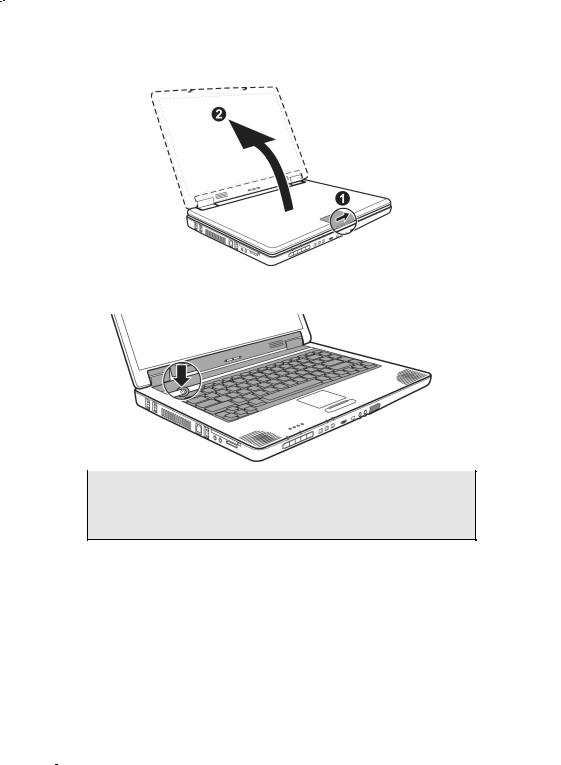
•Open the display by pushing the lock (17) to the right with your thumb and then opening the display to the required position with your thumb and index fingers.
•Switch the notebook on by operating the On/Off Switch (6). The notebook starts and now goes through a number of phases.
ÂNote: Make sure there is no bootable CD (e.g., the Recovery CD) in the CD-ROM drive. Such disks will prevent the operating system from loading off the hard drive.
The operating system is loaded from the hard disk. During the initial set-up, the loading process takes slightly longer than normal to register the operating system and the individual components completely. Your operating system is finished loading when a welcome screen is shown on your display.
18 |
|
VIEWS & HANDLING |

Step 2
Follow the instructions on the screen. Dialogue boxes will explain any steps that need to be taken.
The greeting procedure will guide you through a series of dialogue boxes. The information in each dialogue box will explain the steps that need to be taken.
Should you have any questions just click on  .
.
License Agreement
The greeting procedure also displays the license agreement. Please read this carefully.
It contains important legal information on the use of your software. In order to see the full text, use the mouse and the scroll bar on the right side of the screen to move downwards until you have reached the end of the document. You accept the agreement by clicking on the “I accept the agreement” option field. Only by doing so will you be entitled to use the product under lawful terms and conditions and be entitled to open the sealed Windows® manual.
Step 3
After the login procedure the Windows® desktop appears on your screen.
You will find a brief overview on the following pages.
After the login procedure the Windows® desktop appears on your screen. This can be adjusted so that the screen of your computer looks different.
However, basic operation is guaranteed.
GETTING STARTED
Safety
Handling
Components
Help
Appendix
19
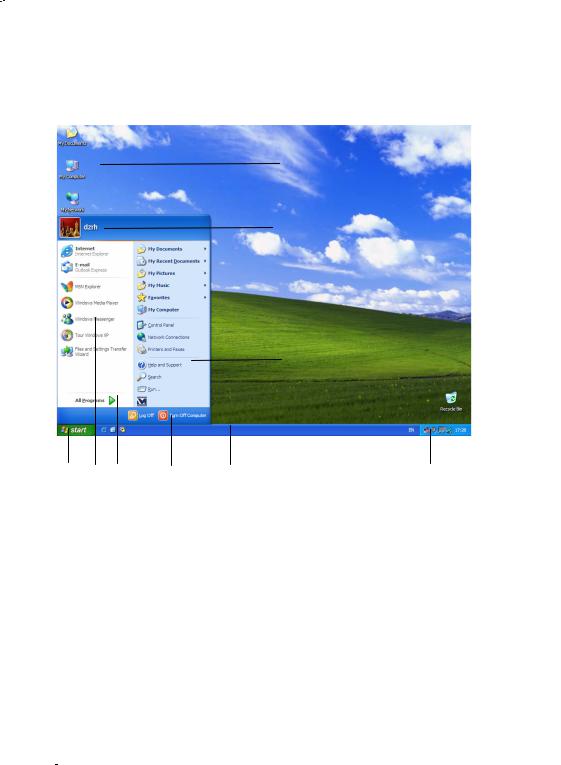
SHORT DESCRIPTION OF THE WINDOWS® DESKTOP
After the login procedure the Windows® XP desktop appears on your screen. (Your desktop might not look exactly like the one shown here.)
t
u
v
Information about your PC
n op q r |
s |
1.Start Button
Clicking the Start button brings up a menu where you can ac-
cess help, software programs, files, and settings. For more information, click Windows® XP Tour on the Start menu.
2.Program Bar
The most commonly used software programs are listed here.
20 |
|
VIEWS & HANDLING |

3.All Programs
All of the software programs installed on your notebook are ordinarily listed here. Click All Programs to reveal an extensive menu.
4.Turn Off Computer
Click this button to shut down Windows® XP and the notebook.
5.Task Bar
Here you receive information and status reports about Windows® XP and which programs are running.
6.Desktop Icons
Desktop icons link to their respective programs. To start a program, double-click its desktop icon.
7.Logged in User
This tells you which user is logged in to your notebook.
8.Control Panel
You can use the icons in Control Panel to change the appearance and functionality of Windows® XP. These icons represent options for configuring your notebook.
9.Windows® XP Help
Here you can find information on using your notebook, networking, backup, and many other tasks.
GETTING STARTED
Safety
Handling
Components
Help
Appendix
21
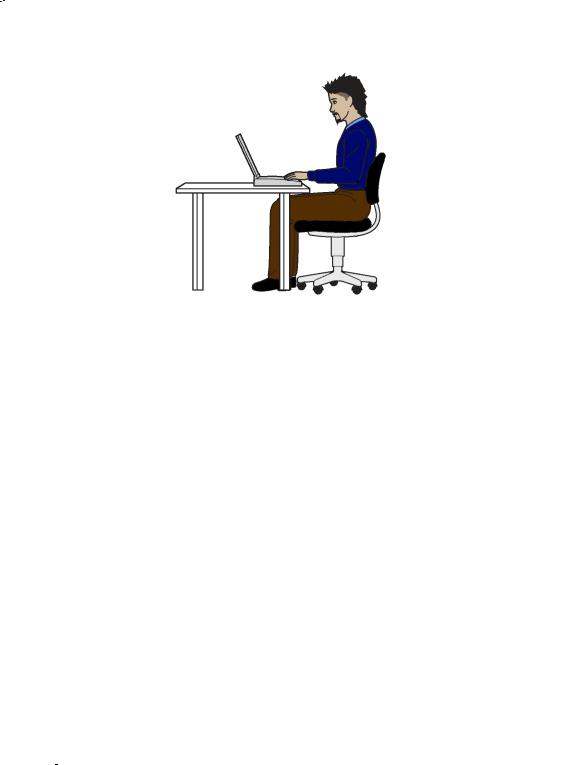
WORKING IN COMFORT
Sitting in one position for long periods can be uncomfortable. To minimize the potential for physical discomfort or injury, it’s important that you maintain proper posture.
•Back – While sitting at your work surface, make sure your back is supported by the chair’s backrest in erect position or angled slightly backwards.
•Arms – Your arms should be relaxed and loose, elbows close to your sides, with forearms and hands approximately parallel to the floor.
•Wrists – Your wrists should be as straight as possible while using the keyboard, mouse or trackball. They should not be bent sideways, or more than 10 degrees up or down.
•Legs – Your thighs should be horizontal or angled slightly downward. Your lower legs should be near a right angle to your thighs. Your feet should rest flat on the floor. If necessary, use a footrest, but double check that you have your seat height adjusted correctly before getting a footrest.
•Head – Your head should be upright or tilted slightly forward. Avoid working with your head or trunk twisted.
•Overall – Change your position frequently and take regular breaks to avoid fatigue.
22 |
|
VIEWS & HANDLING |
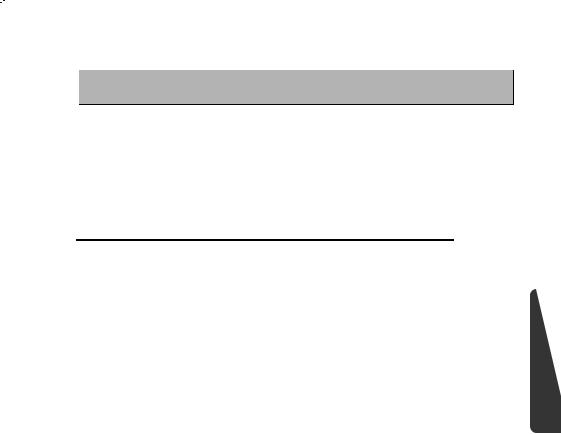
 Chapter 3
Chapter 3
Main Components
Safety
Subject |
Page |
Power Supply ................................................. |
25 |
Display ......................................................... |
32 |
Data entry ..................................................... |
36 |
Hard Drive ..................................................... |
39 |
Optical Drive................................................... |
41 |
Sound Card .................................................... |
49 |
Modem .......................................................... |
50 |
Network......................................................... |
54 |
Multimedia Card Reader ................................... |
59 |
PC Card Slot ................................................... |
60 |
Universal Serial Bus (USB) Port ......................... |
62 |
IEEE 1394 (FireWire) ....................................... |
63 |
Bluetooth ...................................................... |
64 |
Infrared interface ........................................... |
66 |
Software ........................................................ |
66 |
Handling
Components
Help
Appendix

24 |
|
MAIN COMPONENTS |
